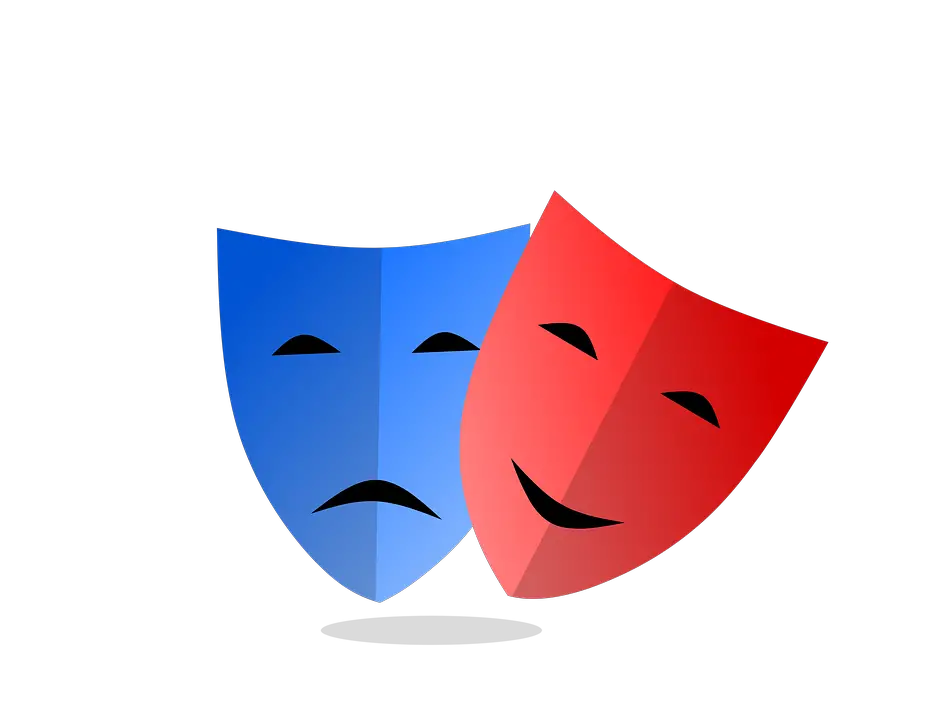The Comedy and Tragedy symbol dates back to Greek Mythology symbol as the sock and buskin.
The masks function as a critical tool for an examination of character and performer action in all periods of theatre, including the most recent.
The Masks Convention
The masks developed as a convention for the projection of action in four basic ways :
1) As a theatrical convention
2) As a dramatic convention
3) As a performance convention
4) As an acting convention
Each of these conventions develops action from a different perspective, through different means, and on different levels of the dramatic and theatrical process.
All of these mask conventions project actions as arising from a dialectical interaction of human potentialities
These various conventions also demonstrate a general progression from an exclusive focus on the projection of character action to an exclusive focus on the projection of performer action.
The Mask as a Theatrical Convention : The mask as a theatrical convention is principally concerned with the projection of character action, though in its latter stages of development, it also accounts for the action of the performer.
The Mask as a Dramatic Convention : The mask as a dramatic convention is concerned with a balanced projection of character and performer action.
The Mask as a Performance Convention : The mask as a performance convention is concerned with the projection of a performer’s action. As a performance convention, the mask has been developed according to four different kinds of processes. These processes have resulted in fundamentally different kinds of performance masks
- The mask as sign
- The mask as essence
- The mask as demonstration
- The mask as actual
The Mask as an Acting Convention : Several acting processes have been developed to support the various mask conventions mentioned above.
Each process is a unique attempt to develop a means for realizing the different kinds of actions projected by each convention.
Each of these acting processes develops a different kind of dialectical tension between the performer and the mask.
There exists a tension between the actor and the mask as a theatrical convention : the actor works to harmonize his impulse with the impulse objectified by the mask.
The Mask
In the acting process is the means for transforming the actor into an image of the essential human reality which characterizes a given period.
Comedy and Tradegy masks changes as the nature of human essence changes.
- An analysis of the mask as an acting convention reveals it to be a significant element of transformation in all approaches to acting.
- The different processes which have developed to create the different kinds of masks reveal special kinds of relationships between the performer and the character’s mask of actions.
- The mask’s development as different kinds of conventions for the projection of action inevitably reflects the essential function of the mask to be a gesture toward character.
- The mask as action aspires toward different images of the character. These images might be conceived and fixed by the dramatist, or they might be chosen by the performer and developed spontaneously within the context of the performance event.
Regardless of who conceives the image or of how it is conveyed. The mask as action enables its wearer to experience his own potential for character.
Old Comedy-drama
- Euripides
- Cleon
- and Socrates.
The masks developed for these contemporary characters were called portrait-masks and were reputed to have been excellent representations.
New Comedy
Here a strange dichotomy between the nature of the drama and the nature of the theatrical mask developed
While New Comedy distinctly differed from that of Old Comedy in its attempt to delineate ordinary human character, the distorted and grotesque mask continued to be used in performance.
The image of the tragic mask with its fixed expression, empty eye sockets, monochromatic complexion, and exaggerated downturned mouth sits next to its comic counterpart as the very emblem of live theatre, as the inter-twined masks of “Comedy” and “Tragedy.


